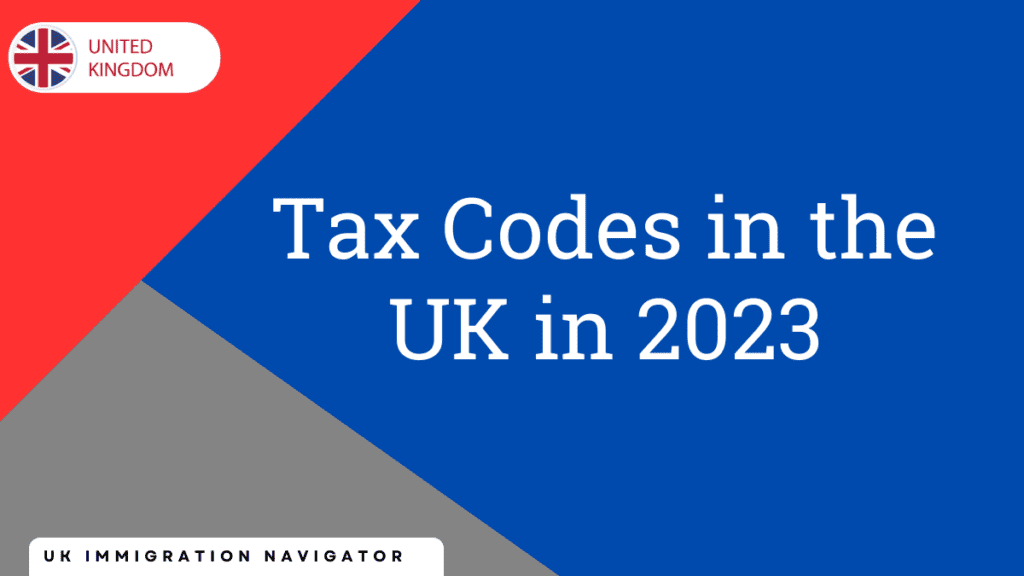Tax codes in the UK can sometimes seem like an enigma wrapped in an alphanumeric puzzle. But fear not, as we embark on a journey to decode these tax codes with the help of our friendly guide, the “UK Immigration Navigator.” So, grab your cup of tea and let’s dive in!
1. Introduction to Tax Codes in the UK

Picture this: Tax codes are like the navigational compass of the UK’s tax system. They guide you through the winding roads of income tax, ensuring you reach your financial destination without a hitch.
2. How Tax Codes in the UK Work

Tax codes are a mix of letters and numbers, and each element serves a unique purpose. Think of them as the secret ingredients that make up your tax recipe.
3. Common Tax Codes in the UK Prefixes
– 1150L: The ‘Everyday’ Tax Code
If you were born after 5th April 1948, this is your go-to tax code. It’s like your tax-free allowance membership card.
– 1250L: The ‘Golden Oldie’ Tax Code
For those born between 6th April 1938 and 5th April 1948, this tax code welcomes you to the tax-free club.
– 1100L: The ‘Vintage’ Tax Code
If your birth certificate predates 6th April 1938, this is your tax-free pass.
– NT: The ‘No Tax’ Code
You hit the tax jackpot! With this code, no tax gets deducted. But remember, this isn’t an invitation to splurge.
– BR: The ‘Basic Rate’ Tax Code
BR is your tag when you have more than one income source or no tax-free allowances. It’s like the default setting for taxation.
4. Decoding Tax Codes in the UK Letters

The letters within a tax code tell a story of your financial life. Here’s a sneak peek at some of these tax code tales:
– L: The ‘Lucky’ Tax Code
This letter signifies your standard tax-free personal allowance. Consider it your financial rabbit’s foot.
– M: The ‘Marriage’ Tax Code
If you’re married and enjoying a tax perk, you’ll see this letter. It means you can share a slice of your tax-free allowance with your spouse.
– N: The ‘Nuptial’ Tax Code
The N code indicates that you’re on the receiving end of a transferred marriage allowance from your spouse.
– S: The ‘Scottish’ Tax Code
If you reside in bonnie Scotland, this code accounts for the unique Scottish rate of income tax.
– T: The ‘Transferred’ Tax Code
T codes are for those who’ve received a transferred marriage allowance from their spouse.
5. Emergency Tax Codes in the UK

Imagine you’ve just landed in the UK, and the taxman isn’t entirely sure about your financial history. In such cases, you might find yourself in an emergency tax situation. This means higher tax deductions temporarily until your tax code gets sorted out.
6. BR Tax Codes in the UK
BR codes come into play when you have multiple income streams or don’t qualify for any tax-free allowances. Think of it as a financial balancing act.
7. D0 and D1 Tax Codes
D0 and D1 codes are like the “double trouble” of tax codes. They’re used when you have multiple jobs or income sources, and they signify that all your income is taxed at either the higher rate (D0) or the additional rate (D1).
8. K Tax Codes
K codes might make you feel like a secret agent, but they’re simply used when you have untaxed income that surpasses your tax-free allowance. The extra income gets deducted from your salary or pension.
9. L Tax Codes
The L code is your ‘License to Tax Freedom.’ It’s the most common tax code, representing the standard tax-free personal allowance.
10. M Tax Codes
M codes are a tax code symbol of love and commitment. They signify that you’ve received the marriage allowance, allowing you to transfer a part of your personal allowance to your spouse.
11. N Tax Codes
N codes are the ‘Nice Gesture’ tax codes. They come into play when you receive a transferred marriage allowance from your spouse.
12. P Tax Codes
P codes are for those in their golden years, aged 65 to 74, who are entitled to the full personal allowance. It’s like a reward for a lifetime of tax contributions.
13. S Tax Codes
If you call Scotland home, S codes are what make your tax world go round. They’re used to calculate the Scottish rate of income tax.
14. T Tax Codes
T codes are a symbol of marital tax harmony. They indicate that you’ve received a transferred marriage allowance from your spouse.
15. Conclusion
Navigating the labyrinth of UK tax codes may seem daunting, but with this guide, you’re better equipped to decipher the tax language. Remember, if you have questions or concerns about your tax code, don’t hesitate to reach out to HMRC or a tax professional for assistance.
FAQs
- How can I find my tax code? To find your tax code, check your payslip or get in touch with HMRC.
- Can my tax code change during the tax year? Absolutely. Your tax code can change if your circumstances change, like getting married or switching jobs.
- What should I do if I suspect my tax code is incorrect? If you think there’s an issue with your tax code, contact HMRC right away to get it sorted.
- What happens if I have more than one job with different tax codes? When you have multiple income sources, your overall income from all sources is considered for tax calculation.
Now, armed with this tax code knowledge, you’re better prepared to navigate the UK’s taxation system. Cheers to a less taxing experience!
| Tax Code | Meaning |
|---|---|
| 1257L | Standard tax code with Personal Allowance |
| BR | Basic Rate (20%) |
| D0 | Higher Rate (40%) |
| D1 | Additional Rate (45%) |
| NT | No Tax |
| K | Complex tax situations |
| S | Scottish Income Tax rates and bands |
| C | Scottish Intermediate Rate |
This table summarizes the meanings of common UK tax codes used to determine income tax. Please note that tax codes can vary based on individual circumstances, and it’s important to regularly check your tax code to ensure accuracy.



